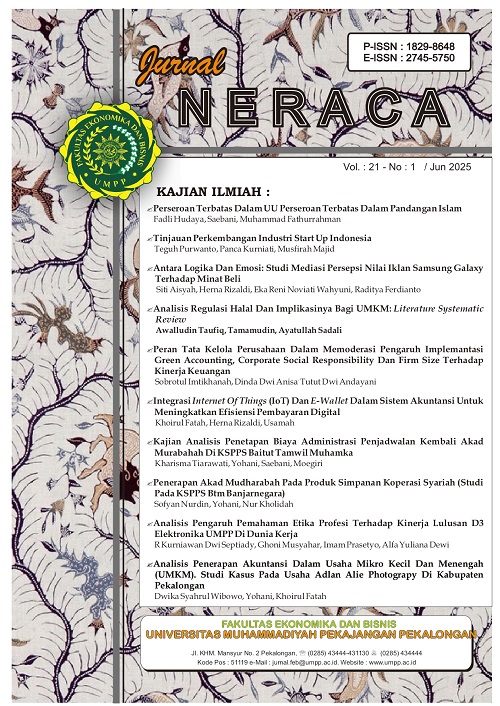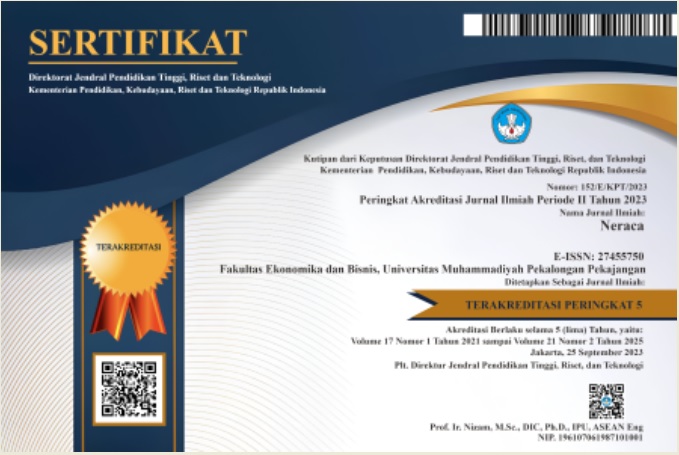ANTARA LOGIKA DAN EMOSI: STUDI MEDIASI PERSEPSI NILAI IKLAN SAMSUNG GALAXY TERHADAP MINAT BELI
DOI:
https://doi.org/10.48144/neraca.v21i1.2109Keywords:
logika, emosi, persepsi_nilai, minat_beli, perilaku_konsumenAbstract
Penelitian ini bertujuan untuk menguji peran mediasi nilai yang dirasakan dalam hubungan antara daya tarik rasional dan daya tarik emosional terhadap minat beli konsumen terhadap produk Samsung Galaxy melalui konteks iklan produk. Penelitian kuantitatif, pengumpulan data dilakukan melalui penyebaran kuesioner elektronik kepada 100 responden menggunakan teknik simple random sampling. Populasi dalam penelitian ini adalah masyarakat di wilayah Purwokerto yang pernah terpapar iklan Samsung Galaxy melalui berbagai media. Analisis data menggunakan metode Partial Least Squares-Structural Equation Modeling (PLS-SEM). Hasil analisis menunjukkan bahwa daya tarik rasional berpengaruh positif dan signifikan terhadap nilai yang dirasakan, namun tidak memiliki pengaruh langsung yang signifikan terhadap minat beli. Nilai yang dirasakan berperan sebagai mediator penuh dalam hubungan antara daya tarik rasional dan minat beli. Sebaliknya, daya tarik emosional terbukti berpengaruh secara positif dan signifikan baik secara langsung terhadap minat beli maupun secara tidak langsung melalui nilai yang dirasakan, sehingga menunjukkan adanya mediasi parsial. Temuan ini mengindikasikan bahwa persepsi nilai berperan sentral dalam menjembatani pengaruh komunikasi pemasaran terhadap intensi perilaku konsumen. Implikasi konseptual dari penelitian ini memperkuat validitas Theory of Planned Behavior dalam konteks pemasaran. Secara praktis, hasil ini menegaskan pentingnya pengembangan strategi komunikasi pemasaran terpadu yang mampu mengombinasikan daya tarik informatif dan emosional secara seimbang.
REFERENSI
Aisyah, S., Rizaldi, H., Wahyuni, E. R. N., & Ferdianto, R. (2024). BAGAIMANA KENIKMATAN BERBELANJA ONLINE MEMPENGARUHI MINAT PEMBELIAN KEMBALI?. Neraca, 20(2), 126-136.
Baheti, G., Jaim, R.K., Jain, N. (2012). The impact of advertising appeals on customer buying behavior. International Journal of research in commerce & management, Vol. No. 3 (2012), Issue. No.11.
Baron, R. M., & Kenny, D. A. (1986). The moderator–mediator variable distinction in social psychological research: Conceptual, strategic, and statistical considerations. Journal of Personality and Social Psychology, 51(6), 1173–1182.
Bazarova, N., Choi, Y.H., Sosik, V.S., Cosley, D., Whitlock, J.L. (2015). Sosial Sharing of Emotions on Facebook: Channel Differences, Satisfaction, and Replies. CSCW 2015, Vancouver, BC, Canada.
Belch, G.E., Belch, M.A. (1998). Advertising and Promotion. New York: Mc Graw-Hill.
Chu, F.G. (1996). Strategy Analysis of Advertising Rational Appeals Strategy. J. Adv. Public. Relat, 8:1-26.
Colliander, J., Marder, B. (2017). ‘Snap happy’ brands: Increasing publicity effectiveness through a snapshot aesthetic when marketing a brand on Instagram.
Comer, J. C., & Wikle, T. A. (2008). Worldwide diffusion of the cellular telephone, 1995–2005. The Professional Geographer, 60(2), 252–269.
Crosno, J.L., Freling, T.H., & Skinner, S.J. (2009). Does brand social power mean market might? Exploring the influence of brand social on brand evaluations. Psychology & marketing, 26 (2), 91-121.
Fredrickson, B. L. (2011). The broaden-and-build theory of positive emotions: Implications for health and well-being. The Positive Psychology of Personal Transformation, 1(1), 7-19.
Hair, J.F., Black, W.C., Babin, B.J., Anderson, R.E. (2010). Multivariate Data Analysis, 7th ed. Prentice Hall, Upper Saddle River. N.J.
Halim, W.Z.W., Hamed, A.B. (2005). Consumer Purchase Intention at traditional restaurant and fast food restaurant. Consumer Behavior.
Hu, G., Bhargava, P., Fuhrmann, S., Ellinger, S., & Spasojevic, N. (2017). Analyzing users' sentiment towards popular consumer industries and brands on Twitter. arXiv.
Huang, L., Mou, J., See-To, E. W. K., & Kim, J. (2019). Consumer perceived value preferences for mobile marketing in China: A mixed method approach. Journal of Retailing and Consumer Services, 48, 70–86.
Hyuna, S.S., Kimb, W., & Lee, M.J. (2011). The impact of advertising on patrons' emotional responses, perceived value, and behavioral intentions in the chain restaurant industry: The moderating role of advertising-induced arousal. International Journal of Hospitality Management, 30, 689–700.
Ingavale, D. (2013). A study on customer satisfaction with reference to service quality in the retail sector. International Journal of Marketing and Technology, 3(1), 1–13.
Kalu, S.E., Daniel, E.C. (2017). Advertising Appeal And Purchase Intention Of Beer Consumers In Port Harcourt. EPRA International Journal of Research and Development (IJRD), Volume: 2.
Khan, S.N., Mohsin, M. (2017). The Power of Emotional Value: Exploring the Effects of Values on Green Product Consumer Choice Behavior. Journal of Cleaner production.
Kim, H.C., Hyun, M.Y. (2016). Predicting the use of smartphone – based Augmented Reality (AR): Does telepresence really help? Computers in Human Behavior, 59: 28-38.
Kotler, P. (1997). Marketing management: Analysis, planning, implementation and control. 9th Edn. New Jersey: Prentice-Hall. 6.
Kotler, P. (2003). Marketing management. 11th Edn. New Jersey: Prentice Hall.
Kotler, P. (2003). Marketing management. 11th Edn. New Jersey: Prentice Hall.
Kotler, P., & Keller, K. L. (2009). Marketing management (13th ed.). Pearson Education.
Lam, A.Y., Lau, M.M., & Cheung, R. (2016). Modelling the relationship among green perceived value, green trust, satisfaction, and repurchase intention of green products. Contemporary Management Research, 12(1), 47–60.
Lee, J., & Yun, T. (2015). The impact of leadership style on employee performance. Journal of Business Research, 68(4), 765–771.
Lee, J., Pee, L.G. (2015). The Relationship between online Trust and Distrust in Business: Testing Mutual Casuality from a Cognitive – Affective Personality System Theory. Asia Pac. J. Inf. Syst., 25, 500-518.
Lin, J.-S., & Huang, C.-L. (2012). The impact of service quality on customer satisfaction in the hotel industry. International Journal of Hospitality Management, 31(3), 486–494.
Lin, L.Y. (2011) The impact of advertising appeals and advertising spokespersons on advertising attitudes and purchase intentions. African Journal of Business Management, Vol. 5 (21), pp. 8446-8457.
Main, K.J., Argo, J.J., Huhmann, B.A. (2004) “Pharmaceutical advertising in the USA: information or influence? International Journal of Advertising, Vol. 23 (01), pp. 119-142.
Mort, M.H.G.S. (2010). The consequence of appraisal emotion, service quality, perceived value and customer satisfaction on repurchase intent in the performing arts. Journal of Services Marketing. 24(2), 170-182.
Neuman, W. L. (2014). Social research methods: Qualitative and quantitative approaches (7th ed.). Pearson Education.
Park, K., Lee, K. (2016). Is green product purchasing an innovative or conspicuous behavior? Sosial behavior and personality, 44 (1): 29-44.
Rizaldi, H. (2022). The influence of brand popularity, perceived quality, price, and need on purchase intention iPhone products in Purwokerto. Jurnal Akuntansi, Manajemen dan Ekonomi, 24(2), 14-22.
Rizaldi, H., Arifiyanto, M., & Hidayah, N. L. (2024, November). What role do credit cards play in impulse buying?. In Economics and Business International Conference Proceeding (Vol. 1, No. 2, pp. 1144-1156).
Schiffman, L. G., & Kanuk, L. L. (2007). Consumer behavior (9th ed.). Pearson Education.
Schmuck, D., Matthes, J., Naderer, B. (2018). Misleading consumers with green advertising? An affect reason-involvement account of greenwashing effects in environmental advertising. J. Advert. 1-19.
Sheth, J. N., Mittal, B., & Newman, B. I. (1991). Customer behavior: Consumer behavior and beyond (2nd ed.). Harcourt Brace Jovanovich.
Siddiqui, A.N. (2014). TV Ads Impact on Consumer Purchase Intention. https://www.researchgate.net/publication/313517197.
Sweeney, J.C., Soutar, G.N. (2001). Consumer Perceived Value: The Development of a Multiple Item Scale. Journal of Retailing. 77, 203-220.
Sweeney, J.C., Soutar, G.N. (2001). Consumer Perceived Value: The Development of a Multiple Item Scale. Journal of Retailing. 77, 203-220.
Turel, O., Serenko, A., & Bontis, N. (2010). User acceptance of hedonic digital artifacts: A theory of consumption values perspective. Information & Management, 47(1), 53–59.
Wang, E.S., & Juan, P. (2016). Entrepreneurial orientation and service innovation on consumer response: A B & B case. Journal of Small Business Management. 54(2), 532–545.
Wijaya, B.S. (2011). New Model of Hierarchy of Effects in Advertising. Proceeding International Seminar on Scientific Issues and Trends. d5-15.
Yang, X., & Zhou, Y.J. (2006). Green value: A new dimension of customer perceived values. China Industrial Economy, 7, 110–116.
Yoo, A., Lee, B., & Park, C. (2010). Consumer behavior patterns in online shopping. Journal of Marketing Research, 47(3), 456–472.
Zawisza, M., Pittard, C. (2015). When Do Warmth and competence Sell Best? The “Golden Quadrant” Shifts as a Function of Congruity with the Product Type, Targets Individual Differences, and Advertising Appeal Type, Basic and Applied Social Psychology, 37 (2): 131-141.










